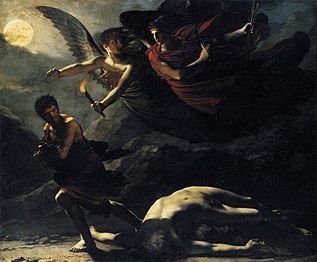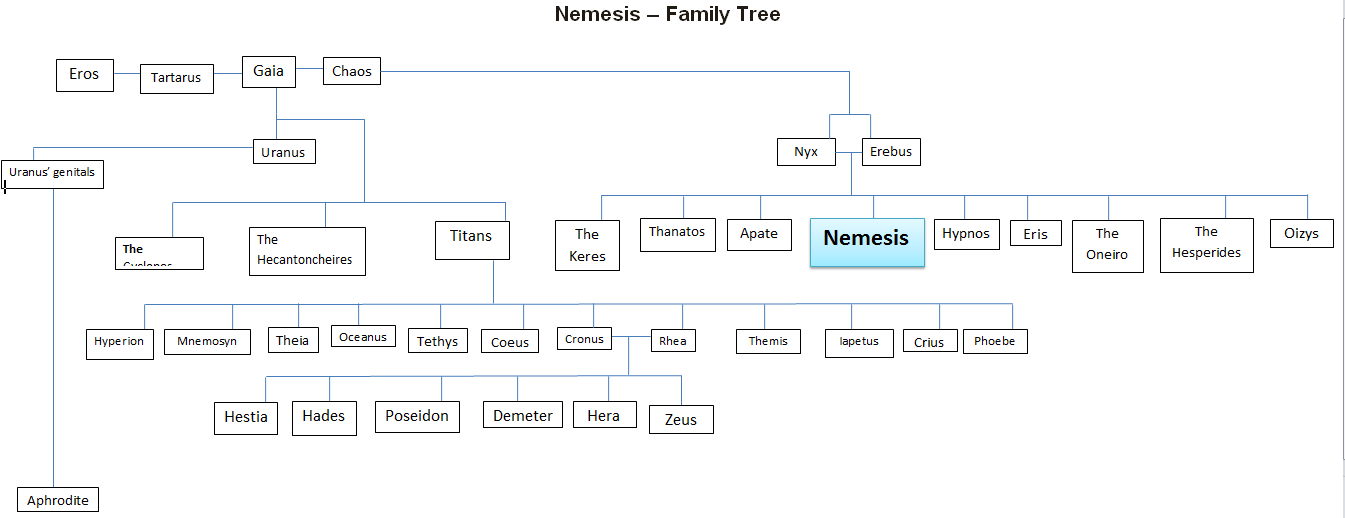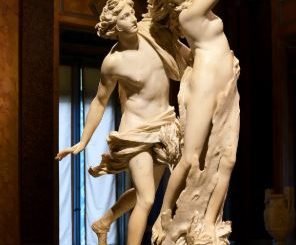Nemesis: Greek Goddess of Retribution and Justice

Nemesis – Greek Goddess of Retribution |Painting: by Alfred Rethel (1837)
Ancient Greek goddess Nemesis was worshiped as the goddess of retribution. She was known for dishing out punishments to people who blasphemed against the gods. She also mercilessly avenged those who unduly acquired immense fortunes at the expense of the poor in the society. As the goddess of retribution, no sinner or criminal was beyond her reach. Commonly called the Winged balancer of life or the Bringer of Justice, Nemesis’ actions were believed to maintain balance in the world, ensuring that happiness and misery remained in perfect balance.
Nemesis in ancient Greek religion
Goddess of: Retribution
Parents: Nyx and Erebus, or Nyx and Oceanus, or Nyx and Zeus
Consort: Zeus, or Tartarus
Siblings: Eris, Dolos, Achlys, Thanatos, the Keres, the Oneiroi, the Moirai, Hypnos
Children: Helen of Troy, the Telchines
Association: Aphrodite, Artemis, Tyche (deity of fortune and prosperity)
Symbol: a whip, a dagger, the scales, sword, a scourge, a measuring rod (or tally stick)
Epithets: Daughter of Justice; Winged balancer of life; Bringer of Justice; Distributor of Fortune
Worship place: Smyrna, the district of Rhamnous
Festival: Nemeseia
Other names: the goddess of Rhamnous, Adrasteia, Erinys
Origin story and family
In most accounts, she was seen as the daughter of Nyx (the Greek goddess of the night) alone. This was the assertion of famous ancient Greek poet Hesiod.
In other cases, Nemeses was the daughter of Nyx and Oceanus, or Nyx and Zeus. Oceanus, the son of Uranus and Gaia, was the god of the river Oceanos.
Her siblings included the likes of Thanotos (the personification of death), the Moirai (the Fates), the Oneiroi (Dreams), Eris (Discord), Apate (Deception), and the Keres (Black Fates).
It was believed that Nemesis laid an egg from which two sets of twins emerged – Helen of Troy and Clytemnestra (the wife of Agamemnon, king of Mycenae), and the Dioscuri, Pollux and Castor. Thus Nemesis was seen as the mother of Helen of Troy, the beautiful princess who triggered the legendary Trojan War.
MORE:
- Hermes: Ancient Greek god of trade, luck, fertility, sleep, and thieves
- Demeter: Greek goddess of agriculture and grains
Nemesis Meaning
Nemesis’ name evokes a meaning of “to give what is due”. Her name is most likely related to νέμειν némein, which is a Greek term that raises notions of “judgment” and “distribution”.
There is a reasonable explanation as to why Nemesis was always associated with Nyx. Hesiod, in his Theogony, opines that Nyx gave birth to Nemesis as some sort of control mechanism to flawed humans whose only destiny was in the bosom of death.
Nemesis’ importance and role in the Greek pantheon

Nemesis – Greek Goddess of Retribution | A painting by Pierre-Paul Prud’hon in 1808 showing Justice (Dike, on the left) and Divine Vengeance (Nemesis on the right) pursuing the criminal murderer
Ancient Greeks always loved themes of divine retribution and accepting punishments and rewards that are due them from the gods. The Hellenistic period (323-31 BCE) was rife with those kinds of themes, especially in the works of many Greek tragedy writers such as Sophocles, Aeschylus, and Euripides.
In carrying out her duties, Nemesis was believed to be merciless (Erinys) when it came to dishing punishments to mortals that were arrogant before the gods. In ancient Greece, the worst forms of sins were those that were hubris in nature. Almost in every instance, the culprit met dire consequences for the slightest bit of arrogance or disrespect towards any of the gods. This is where Nemesis came in – she was the tool the gods used to exact revenge on mortals.
The ancient Greeks and Romans believed that she was the deity who restrained the excess of mortals; for without Nemesis, mortals would be left wallow in their sea of hubris. Nemesis thus checked the insolent behaviors of the ancients.
Worship
Many scholars actually state that Nemesis was a very old Greek deity, appearing long before the likes of Zeus and other Olympians. This was evident at her worship place in the district of Rhamnous. The people in that district saw Nemesis as the daughter of Oceanus, an ancient river deity whose ocean surrounds the world. Others have claimed that Nemesis’ worship began in Greek cities along the Aegean coast of Anatolia, particularly in places like Smyrna (modern-day Izmir, Turkey).
Nemesis Power
Such was the dread and mystery associated with the goddess Nyx, making her a very formidable Greek deity, one that that even Zeus – the king of the Olympians – feared. Thus Nemesis’ association with Nyx and Erebus (deity of darkness) is not misplaced. Nemesis, like the night or darkness, was a deity no mortal could escape from.
It must be noted that the ancient Greeks did not try to place her in either a good or bad category. They saw her role as vital to maintaining balance in the universe. She was a deity who, in the simplest of way of putting it, gave people what they deserve. So it means that for those whose actions were noble and justice, she distributed good fortune to them; and for those bad elements in the society, Nemesis rained down misery and pain on them.
Depictions, symbols and epithets
In general, Nemesis is shown as winged goddess, almost similar in stature as another winged deity, the goddess Nike (goddess of victory). It has also been noted that earlier depictions of Nemesis made her slightly resemble Aphrodite, the Greek goddess of love and passion. Aphrodite herself has sometimes been associated with some features of Nemesis.
Nemesis’ means of transportation is usually a chariot that is pulled by griffins. And in almost every time, she is seen wielding a sword or a dagger or a whip, a reflection of her role as the deity who meted out punishments to mortals.
Like many ancient Greek deities, Nemesis has her fair share of epithets and appellations. For example, the second-century AD Roman poet Mesomedes described Nemesis as the “dark-faced goddess” and the “balancer of life”. Mesomedes’ description of her as dark-faced is in reflection of the traits she most likely picked from her mother Nyx, the fierce goddess of the night.
Many of her epithets hail her as a relentless deity who works very hard to make sure that that people get what is due them based on their actions. It is therefore not surprising that her name literally translates into “the bringer of justice”.
Popular symbols of Nemesis include the whip, the dagger, scales, sword and a scourge. Others are the measuring rod (or tally stick), a bridle and a chariot. Almost all of those symbols run in congruence with her role in the pantheon. For one to exact punishment, measurement of the said bad behavior is required; likewise a punishing tool, say a whip or sword, is also required.
Read More:
- 15 Interesting Facts about the Greek God of Medicine, Asclepius
- Myths and Facts about Ares, the Greek God of War
Nemesis and Narcissus
A hunter from Thespiae, Narcissus was perhaps the most beautiful male mortal in ancient Greek mythology. However, his pride knew no bounds; he is believed to have loathed those who loved him, making them go into severe bouts of depression, with some of them even committing suicide in a bid to prove their love to Narcissus.
Nemesis sprung to action after Narcissus had early on turned down the love proposal of the nymph Echo. Heartbroken and crushed by Narcissus’ rejection, Echo whittles away, until only her voice remains.

Narcissus by Italian painter Caravaggio (29 September 1571 – 18 July 1610)
Cases of this nature were just some of the wrongs that the goddess Nemesis was in the business of rectifying. As a result of the extensive amounts of vanity from Narcissus, Nemesis is believed to have lured Narcissus to a river nearby; whereupon Narcissus seeing his own reflection fell madly in love with it. Unbeknownst to Narcissus that the person he saw in the river was none other than his own reflection, he tried to make the image fall in love with him. Exhausted by all his vain attempts, Narcissus simply faded away by the river side and turned into white and gold flower.
Did you know: the psychological term “narcissism” is reasoned to have emerged from the Greek mythical character Narcissus? A narcissist is someone who is constantly obsessed with himself/herself, in terms of the perception the public has on them.
Read More:
Interesting Facts about Nemesis
And just to re-emphasize just how pervasive she was, Hesiod’s Theogony stated that Nemesis is the sister of the Moirai (the Fates), the Oneiro (Dreams), Eris (Discord) and the Keres (Black Fates). Many of those concepts – i.e. dreams, fate, and doomed fates – run in line with the inevitable notion of nemesis.
When she is not seen as the consort of Zeus, Nemesis is seen as the consort of Tartarus – a primordial force of pitch darkness. Tartarus is also the name the ancient Greeks gave to the deep abyss where the wicked spend an eternity. Tartarus was the prison the Olympians imprisoned the Titans in.
In addition to being called the goddess of Rhamnous [owing to her association with the ancient remote district of Rhamnous], Nemesis has sometimes been called Adrasteia – a common epithet often used for ancient Greek goddesses. The name means “she who cannot be avoided”.
In some cases, as stated by the German mythographer Otto Gruppe (1851-1921), Nemesis’ name has elicited a feeling of resentment, perhaps as a result of events where one feels that justice must be served.
Her name was quite common in many Greek tragedies, where she played the role of someone who avenged a crime, or say a being that punished people for their insolent behavior.
In terms of her origin story, Gaius Julius Hyginus – a Latin scholar from the era of Caesar Augustus – described her as the daughter of Erebus and Nyx. Erebus was a primordial deity darkness who was born of Chaos.
Nemesis is believed to have conceived Helen of Troy after Zeus (in the form of goose) mated with her. To flee Zeus’ advances, Nemesis is believed to have shape-shifted into a swan. But the persistent King of the Olympians in turn turned into a goose. And just before she could turn back to her old form, she laid an egg, which ultimately hatched and brought forth Helen of Troy, Clytemnestra, the Dioscuri, Castor and Pollux.
The ancient Greeks, particularly those in ancient Athens, had a festival called Nemeseia in honor of Nemesis. The participants prayed and offered sacrifices in a bid to avoid the wrath of the dead on the living.
Often times, Nemesis has been associated with the Greek goddess of love Aphrodite and the goddess of the hunt Artemis.
Family tree of Nemesis

Nemesis in Greek mythology
For the Greeks, Nemesis, a personification of retribution, was the offspring of Nyx (Night) and Erebus (Darkness). Those two deities were in turn the children of primordial deity Chaos, a gaping void that preceded the creation of the universe.
According to the ancient Greek poet Hesiod, Nemesis had a number of siblings, including Thanatos (Death) and Hypnos (sleep). Other siblings of Nemesis are: Moros (Doom), Apate (Deception), Geras (Old Age), Eris (Strife), Oizys (Suffering), , and the Underworld boatman Charon.



























